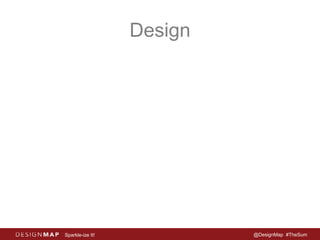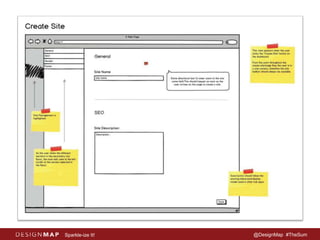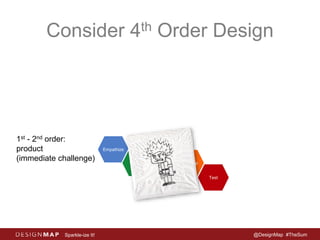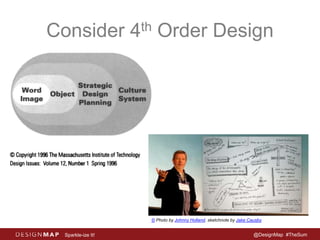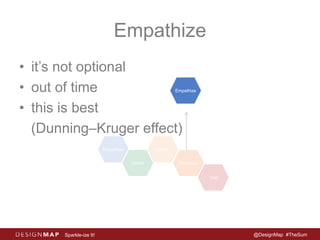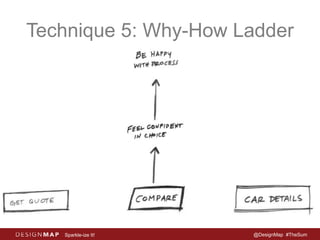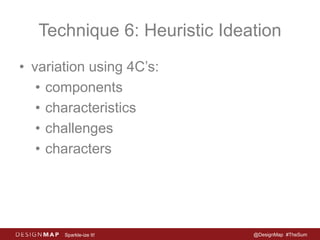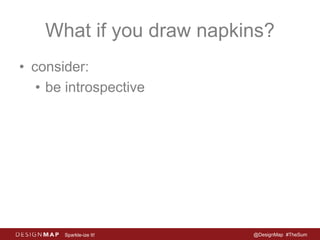Sparkle-ize it Talk and Workshop from The Sum Conference
- 1. The Sum Sparkle-ize It Workhop!!! <3 @DesignMap #TheSum
- 2. What I’m doing: Workshop 1. Talk (45 min) 2. Break (15 min) 3. Divide into 8 groups 4. Napkin One: (60 min) 5. Vote on napkin to use 6. Identify if someone needs to role-play 7. Choose tactic to try 8. Try it 9. Share (30 min) 10.Napkin Two (ditto) Sparkle-ize It! @DesignMap #TheSum
- 3. What I’m doing: Talk 1. What is “getting a napkin”? 2. How does it relate to design thinking? 3. How does it relate to roles besides design? 4. What is “sparkle-izing”? 5. Example of getting a napkin 6. 7 tactics for ideating. 7. NB 8. What if you draw on napkins? 9. Conclusion, questions, war stories…. Sparkle-ize It! @DesignMap #TheSum
- 4. Sparkle-ize It! @DesignMap #TheSum
- 5. Sparkle-ize It! @DesignMap #TheSum
- 6. Sparkle-ize It! @DesignMap #TheSum
- 7. Sparkle-ize It! @DesignMap #TheSum
- 8. “Design Thinking” Empathize Define Sparkle-ize It! Ideate Prototype Test @DesignMap #TheSum
- 9. = Design Empathize Define Sparkle-ize It! Ideate Prototype Test @DesignMap #TheSum
- 10. Empathize Define Ideate Prototype Test = Design Sparkle-ize It! @DesignMap #TheSum
- 11. The outline of a solution that kills the chance for others to make meaningful contributions. Sparkle-ize It! @DesignMap #TheSum
- 12. Design Sparkle-ize It! @DesignMap #TheSum
- 13. Design Communications Sparkle-ize It! @DesignMap #TheSum
- 14. Design Communications Product Managers Sparkle-ize It! @DesignMap #TheSum
- 15. Sparkle-ize It! @DesignMap #TheSum
- 16. Design Communications Product Managers Teachers Developers Sparkle-ize It! @DesignMap #TheSum
- 17. Design Communications Product Managers Teachers Developers Aestheticians Sparkle-ize It! @DesignMap #TheSum
- 18. Sparkle-ize It! @DesignMap #TheSum
- 19. Design Communications Product Managers Teachers Developers Aestheticians Parents Sparkle-ize It! @DesignMap #TheSum
- 20. “Jazz it up a bit.”
- 21. “Make it look good.”
- 23. “Just be creative with it.”
- 24. “Make it sexy.”
- 25. “We need more eye candy.”
- 26. “Fill in the details.”
- 27. “Do your...”
- 28. * * * * * * * * * * ** **
- 29. Example Sparkle-ize It! @DesignMap #TheSum
- 30. Sparkle-ize It! @DesignMap #TheSum
- 31. Sparkle-ize It! @DesignMap #TheSum
- 32. “We hope by answering these questions we can get to the heart of the requirements that you expressed in your document.” Sparkle-ize It! @DesignMap #TheSum
- 33. Sparkle-ize It! @DesignMap #TheSum
- 34. Sparkle-ize It! @DesignMap #TheSum
- 35. So, what to do? Sparkle-ize It! @DesignMap #TheSum
- 36. Consider 4th Order Design Sparkle-ize It! Empathize Define Ideate Prototype Test @DesignMap #TheSum 1st - 2nd order: product (immediate challenge)
- 37. Consider 4th Order Design 4th order: system / relationship Sparkle-ize It! Empathize Define Ideate Prototype Test Empathize Define Ideate Prototype Test @DesignMap #TheSum 1st - 2nd order: product
- 38. Consider 4th Order Design © Photo by Johnny Holland, sketchnote by Jake Causby Sparkle-ize It! @DesignMap #TheSum
- 39. Consider 4th Order Design 4th order: system / relationship Sparkle-ize It! Empathize Define Ideate Prototype Test @DesignMap #TheSum Empathize 1st - 2nd order: product
- 40. Empathize Empathize Define Ideate Empathize Prototype Test Sparkle-ize It! @DesignMap #TheSum
- 41. Empathize • it’s not optional Empathize Define Ideate Empathize Prototype Test Sparkle-ize It! @DesignMap #TheSum
- 42. Empathize • it’s not optional • out of time Empathize Define Ideate Empathize Prototype Test Sparkle-ize It! @DesignMap #TheSum
- 43. Empathize Empathize Define Ideate Prototype Test Empathize • it’s not optional • out of time • this is best Sparkle-ize It! @DesignMap #TheSum
- 44. Empathize • it’s not optional • out of time • this is best (Dunning–Kruger effect) Empathize Define Ideate Prototype Test Empathize Sparkle-ize It! @DesignMap #TheSum
- 45. The fool doth think he is wise, but the wise man knows himself to be a fool. Sparkle-ize It! @DesignMap #TheSum
- 46. Empathize Empathize Define Ideate Prototype Test Empathize • it’s not optional • out of time • this is best • this is all your job is Sparkle-ize It! @DesignMap #TheSum
- 47. Empathize Empathize Define Ideate Prototype Test Empathize • it’s not optional • out of time • this is best • this is all your job is • it’s hard! Sparkle-ize It! @DesignMap #TheSum
- 48. Reasons of Opportunity • it’s not optional • out of time • this is best • this is all your job entails • it’s hard! Sparkle-ize It! @DesignMap #TheSum
- 49. Consider 4th Order Design 4th order: system / relationship Sparkle-ize It! Empathize Define Ideate Prototype Test @DesignMap #TheSum Empathize 1st - 2nd order: product
- 50. Consider 4th Order Design 4th order: system / relationship Sparkle-ize It! Empathize Define Ideate Prototype Test @DesignMap #TheSum Empathize 1st - 2nd order: product
- 51. Sparkle-ize It! @DesignMap #TheSum
- 52. 7 Techniques Sparkle-ize It! @DesignMap #TheSum
- 53. Technique 1: 3 Things • ask: • most important thing this does • things you wish this did better • words you’d use to describe this • make three new versions Sparkle-ize It! @DesignMap #TheSum
- 54. Technique 2: Concept Map Sparkle-ize It! @DesignMap #TheSum
- 55. Technique 2: Concept Map Sparkle-ize It! @DesignMap #TheSum
- 56. Technique 3: Competitive Analysis Sparkle-ize It! @DesignMap #TheSum
- 57. Technique 4: Re-Trace Their Steps Sparkle-ize It! @DesignMap #TheSum
- 58. Technique 5: Why-How Ladder Sparkle-ize It! @DesignMap #TheSum why how ? ? ?
- 59. Technique 5: Why-How Ladder Sparkle-ize It! @DesignMap #TheSum
- 60. Technique 5: Why-How Ladder Sparkle-ize It! @DesignMap #TheSum
- 61. Technique 5: Why-How Ladder Sparkle-ize It! @DesignMap #TheSum
- 62. Technique 5: Why-How Ladder Sparkle-ize It! @DesignMap #TheSum
- 63. Technique 5: Why-How Ladder Sparkle-ize It! @DesignMap #TheSum
- 64. Technique 5: Why-How Ladder Sparkle-ize It! @DesignMap #TheSum
- 65. Technique 6: Heuristic Ideation • variation using 4C’s: • components • characteristics • challenges • characters Sparkle-ize It! @DesignMap #TheSum
- 66. Technique 6: Heuristic Ideation Brad Mike Molly Kristen drive to dealer dealer-generated content? show reviews / ratings of dealers, any dealer perks (gas cards, coffee, etc.) show reviews / ratings of dealers schedule test drive compare cars (more page views) collaborative comparison selection price focus let select comparison criteria let select comparison criteria read more details magazine-style format, integrated content larger type! let select details of interest, make content easy to find and parse let select details of interest Sparkle-ize It! @DesignMap #TheSum
- 67. Technique 7: Business Model Canvas Sparkle-ize It! @DesignMap #TheSum
- 68. Sparkle-ize It! @DesignMap #TheSum
- 69. NB Sparkle-ize It! @DesignMap #TheSum
- 70. Nota Bene • Not me vs. you • No thick skins Sparkle-ize It! @DesignMap #TheSum
- 71. Nota Bene • Give good feedback: • Try, “I like…” / “I wish…” / “What if…” (IL/IW/WI) • State the specific observation and explain the impact. • Be direct, respectful, and sincere (don’t say, “You need to…”.) • If you have something nice to say, please say it. • Pause and wait for reactions. Sparkle-ize It! @DesignMap #TheSum
- 72. What if you draw napkins? • consider: • be introspective Sparkle-ize It! @DesignMap #TheSum
- 73. http://www.dubberly.com/articles/stevejobs.html Sparkle-ize It! @DesignMap #TheSum
- 74. What if you draw napkins? • consider: • be introspective • be inquisitive Sparkle-ize It! @DesignMap #TheSum
- 75. What if you draw napkins? • consider: • be introspective • be inquisitive • don’t take it personally Sparkle-ize It! @DesignMap #TheSum
- 76. What if you draw napkins? • consider: • be introspective • be inquisitive • don’t take it personally • when is it ok? Sparkle-ize It! @DesignMap #TheSum
- 77. The Long Game Sparkle-ize It! @DesignMap #TheSum
- 78. Sparkle-ize It! @DesignMap #TheSum
- 79. Giants • Richard Buchanan • Toby Golsby-Smith • Gamestorming, by Dave Gray, Sunni Brown, James Macanufo • Design Thinking, edited by Thomas Lockwood • Hugh Dubberly, Dubberly Design Office • dschool.stanford.edu • Edward Tauber, Heuristic Ideation Technique • Alexander Osterwalder, Business Model Canvas Sparkle-ize It! @DesignMap #TheSum
- 80. Future Giants • Emily Brower Auchard • Ryan Reposar, Dubberly Design Office • Chris Hoover, Openet • DesignMap: Nathan Kendrick, Greg Baker, Chuck Moore, Jason Fraser, Ryan Cornwell, Kana Knaak, Mike Aurelio, Priyanka Patel, Tin Phatanapirom, Rona Asuncion, Ben Tremper, Rachel Hallock, Rob Gardziel, Nick Smith, Eddie Sheih, Matt Leigh, James Rafferty, Tiffany Chen, Josh Rautenberg, Patrick Leahy Sparkle-ize It! @DesignMap #TheSum
- 81. Good Luck! Audrey Crane audrey@designmap.com @audcrane @designmap #TheSum Sparkle-ize It! @DesignMap #TheSum
- 82. What I’m doing: Workshop 1. Talk (45 min) 2. Break (15 min) 3. Divide into 8 groups 4. Napkin One: (60 min) 5. Vote on napkin to use 6. Identify if someone needs to role-play 7. Choose tactic to try 8. Try it 9. Share (30 min) 10.Napkin Two (ditto) Sparkle-ize It! @DesignMap #TheSum
Editor's Notes
- So here’s my plan. How many of you know this show called “Smash”? It’s about a Broadway musical. I loved this show because I have background in theater, and it was accurate enough (not that I’ve ever been on Broadway, but true enough to my experience) that I loved it. Alas, it’s canceled now, but I wanted to share this scene with you. They’re in rehearsal for the show, and in the scene I’m about to show you, the director has just left the show, and they’ve decided to make the show’s composer into the director. So this guy is an inexperienced director, working with this leading lady.
- So here’s my plan. How many of you know this show called “Smash”? It’s about a Broadway musical. I loved this show because I have background in theater, and it was accurate enough (not that I’ve ever been on Broadway, but true enough to my experience) that I loved it. Alas, it’s canceled now, but I wanted to share this scene with you. They’re in rehearsal for the show, and in the scene I’m about to show you, the director has just left the show, and they’ve decided to make the show’s composer into the director. So this guy is an inexperienced director, working with this leading lady.
- Anyone here do any acting or directing? What did he just do? Yes, this is what’s know as a “line reading”. Theater is an old profession, with well-established etiquette, and this breaks a well known rule. The director is essentially saying… This happens to designers too. It looks like this…
- At one point in every designer’s career, a colleague, boss or client drops by with napkin sketch in hand and asks, “Can you just take this drawing and make it pretty?” (Ok, it doesn’t have to be a napkin) This feels like the moral equivalent of a line reading.
- This is frustrating for the same reason it is to actors – we have something to contribute, but we feel like we don’t have an opportunity. These requests frustrate us. Why? Because designing is much more than gussying up someone else’s sketch. It’s a process that includes everything from defining user needs and concepting to prototyping and testing— a process which is now called “Design Thinking.”
- This model, from Stanford’s d.school – For the purposes of this talk, pretty much any design process model works. The important part is that empathize is the first step, that there is ideating, and prototyping.
- This “design thinking”, is what we do when we design a product. This IS design.
- And this napkin sketch seems to be saying to us, “Forget it, your contribution is not needed here, just make it pretty.
- For today, let’s give it a specific definition The outline of a solution that eliminates the opportunity for others to make a meaningful contribution. (Sometimes you get a drawing but they actually mean it as the beginning of the conversation. If you can use that old improv technique of “yes, and…” successfully, you didn’t really “get a napkin” By the definition I’m proposing.)
- So getting a napkin doesn’t just happen to designers, it happens to all kinds of people.
- Nothing makes a communications professional crazier than a request for a “press release” about something that isn’t news. Writing and distributing a release can’t turn a new package design into important industry news.
- And you’d be hard pressed to find a product manager who hasn’t wrangled with a sales and marketing over adding a new feature the CEO dreamed up in the shower (we call this ECD). I have a friend who’s a Product Manager that has a researcher that comes to her with recommendations from every study not findings, but recommendations, “Here’s what you should do.” That’s a napkin too.
- A teacher having a lesson plan dictated for them might be getting a napkin.
- Many CEOs or COOs have a background in engineering, not business, and not only have ideas about how long something should take, but how it should be implemented.
- It really can happen to anyone. In fact, just last week I was chatting with an aesthetician who was telling me her only pet peeve (this is one of my favorite questions to ask people in professions I’m unfamiliar with) was when a client came in for a facial and knew everything about their skin and what needed done, just telling her what to do. She’d been given a napkin.
- Here’s another form… And as parents we don’t really like it either, We have to do something of our own in addition to these dictates from our kids. We want to contribute to making Christmas special In a more meaningful way than taking orders.
- What all of these people have in common is that they have some process they go through which is key to how they contribute the best they have to offer and it can get stomped on with a literal or figurative napkin. And then what happens? You are handed a napkin and the contribution that’s asked of you is to…
- And it goes by different names: Jazz it up a bit
- Make it look good
- “Add some lipstick
- Just be creative with it
- Make it sexy variation Make it pop
- We need more eye candy
- Relevant to non-designers Fill in the details
- Do your (wiggle fingers like magic)… Or, as I like to call it…
- Who’s had this happen? who’s given someone a napkin before?
- We’ve encountered our share of clients who want us to implement their UX design specifications. Sometimes we wonder if they want us to help them or their users. Of course, we’re in the business of helping their users and sometimes that delta between user needs and client wants creates tension. Here’s an example of just such a situation.
- Tool accessibility Wireframing tools like Balsamiq and Axure are used sometimes by clients to ‘show’ us what they want. They are the digital equivalent of napkin sketches. Here’s an example of one. The yellow notes provided very specific instructions on how the user is interacting with the page.
- This was very early in the process, and it was really specific. We were concerned that we didn’t understand the goals, and that there were some conflicting issues within this page and with the larger system it lived in. Story I’ll go through tomorrow… This didn’t go as well as we’d hoped. And we’d like encounters like this to go better in the future. So what do we do differently? Is there a systematic approach to improving how we respond to napkins?
- Our client’s sketches didn’t make sense to from a user flow and logic point of view. So we backed up, found the issues and put together a set of questions to see if we could unpack the problem with the client. This was with the stated purpose of understanding the requirements. From a design process point of view, these questions are working on two levels. The obvious level is the ‘selection’ of the actual UX design. The less obvious, more subtle purpose is to uncover the client’s point of view. Do they see these questions as choices? Do they understand how these decisions effect overall UX flow and, ultimately, users? These questions address the role of design in the client’s own process and work culture.
- Unfortunately, as you can see from the illustration, the client didn’t respond as we might have hoped. This image could be titled “All is Lost.” Particularly revealing is the comment “I’m not sure by answering these questions it gets us an answer.”
- The remaining comments, in this particular case, were yet more drawings—this time done by hand—of how the application should function. The drawings were helpful, if we could use them as a means to get to deeper underlying decisions or to ideate from. But as a literal final implementation, they were…not.
- …so when this napkin seems to be squashing our ambition to design a great product, instead of being frustrated, it was time for us to level up –
- …to apply design thinking to this new problem, which was a different order problem.
- Richard Buchanan calls this third- and fourth-order design thinking. Buchanan is a professor of design, at CMU for a long time and now at Case Western. He’s well-known for extending the application of design into new areas of theory and practice. How many people know Richard Buchanan? We can think of the first and second orders as designing things. and then third and fourth orders we can call strategic and cultural for this talk – systems. This idea first showed up in 1992 in an article in Design Issues from MIT press – an article that astonishingly included no drawings This picture is from Toby Golsby-Smith’s 1996 article in the same journal.
- Starting with, how can you empathize with the person who gave you a napkin?
- What are some reasons they might have done that?
- Here are possible reasons for ‘sparkelize’ requests: it’s already in a contract or something
- Your colleague/boss/client has no time to think about or discuss alternatives. They’re looking for an implementation now.
- The requestor believes the best solution is on the napkin. They’ve done the heavy lifting and no more questions about strategy and goals are needed. All they need a ‘design.’
- The Dunning–Kruger effect is a cognitive bias manifesting in two principal ways: unskilled individuals tend to suffer from illusory superiority, mistakenly rating their ability much higher than is accurate, while highly skilled individuals tend to rate their ability lower than is accurate.
- Confucius ("Real knowledge is to know the extent of one's ignorance."), Socrates ("I know that I know nothing” Bertrand Russell ("One of the painful things about our time is that those who feel certainty are stupid, and those with any imagination and understanding are filled with doubt and indecision."), Charles Darwin, whom they quoted in their original paper ("ignorance more frequently begets confidence than does knowledge"). Geraint Fuller, commenting on the paper, noted that Shakespeare expressed similar sentiment in As You Like It ("The Foole doth thinke he is wise, but the wiseman knowes himselfe to be a Foole."
- Your requestor believes design’s purpose is to their work look pretty and classy.
- Your colleague/boss/client is having trouble articulating their goal with words and thinks a picture would make it all clear We often assume the fourth one the requestor’s point of view. Remember it may not be, THIS ISN’T GOOD IT’S POSSIBLE IT’S ACTUALLY NOT A NAPKIN and learning more about motivations can help you decide what tactics to use so you can do a better job.
- These reasons can be taken advantage of…
- …so once you’ve empathized…
- you can work backwards through our process, ideating, defining and sometimes even get to empathizing… Just going back even one step is pretty sweet – tossing the napkin and starting over is rarely super effective or fun.
- Trying to toss the napkin and start over is rarely super effective or fun. It’s also kind of insulting And you may be throwing away important stuff How can you suss out and use that important stuff to back through the design process into ideation?
- 7 techniques for ideating from a napkin prototype Collected and invented
- Tell me three important things about this. Let's do a version that optimizes for each of those three things and see what we find. Get Curious Instead of rolling your eyes, get curious. Ask as the who, what, why and how questions to find out where they are in the design thinking process. Here are some questions to keep on hand for your discovery process. --What are the three most important things that you are trying to accomplish with this napkin sketch? (Ideating) --What three words would you use to describe what is happening here? (Ideating) --If you had to pick one word/idea to focus on which would it be? (Selection) --Do you think we can come up with three ways to show that one idea? (Prototyping) Ideally, answers to these questions will open your discussion and uncover where your napkin sketcher is in the design thinking process. Does your colleague think they are prototyping but you see need to go back for user research and more creative thinking about solutions? Or do they think they’re done but you see a need for concept testing and perhaps even another entire iteration? PUT EXAMPLE HERE
- List the objects. Draw in their relationships. Label the relationships. Revise.
- List the objects. Draw in their relationships. Label the relationships. Revise.
- Not personal
- ”I heard you say…” but with pictures. Play It Back Repeat back to them what they’ve described they need to be sure you understand to drive more conversation and to give you an opportunity to ask questions. “I heard you say….” Sometimes hearing the same words out of another mouth else will prompt new thoughts and considerations from the requestor. It’s important that this is NOT ADDITIVE And it’s conversational (in person)
- Why-How Laddering from Stanford ‘why’ yields more abstract statements and meaningful but not as directly actionable ‘how’ yields specific statements, less meaningful, more directly actionable Climb up (‘why?’) and down (how?) in branches to flesh out a set of needs for your user. There will also be multiple answers to your ‘whys’ and ‘hows’ – branch out and write those down.
- A napkins is basically a “how” So we’ll start there – what are the details in their napkin that are important?
- Then for each one of these, move up – why does the user need to compare?
- We can go a step further – we, and she, wants her to be happy with the car buying process. Now we can move down to look at alternative “how’s” – how else could she be happy with the process?
- Maybe the site acts as a partner… How else could the user feel confident with their choice?
- Maybe there are car reviews…
- Maybe we partner with dealers that provide a warrantee. So you see we can use this to drive more ideas and a deeper understanding of goals Out of the specific details of the napkin. This also helps make your process transparent! Ideally, could drive back to empathizing, surfacing holes and questions.
- Heuristic ideation technique (HIT) was developed by Edward Tauber, described recently in Gamestorming. I’m describing a variation Build a matrix of two categories of attributes. (Components, Characteristics, Challenges, Characters?) Fill in the cells. (http://www.gogamestorm.com/?p=470)
- Characters across the top – personas Components down the left – features
- Developed by Alexander Osterwalder (http://en.wikipedia.org/wiki/Business_Model_Canvas)
- This is tricky, kind of turning the tables on them because you’re using their tool! Relevant if the draw-er is an executive or product owner.
- When you try any of these techniques, remember that it may feel to them at first like you’re making their jobs harder. Do everything you can to find common points of reference or, again, empathize with them. Creating an “us versus them” situation only makes the situation worse. Remember: They Are Not Designers One point for designers (or other creative professionals) to remember is that your requestor did not go to design school. They are not as able to separate themselves from their work and their skins are not as thick. Designers are used to criticism. It’s what they want. Not so much with the rest of the world, so tread lightly when pointing out problems with the napkin. Give feedback respectfully…
- Give feedback respectfully…
- think about this… from http://www.dubberly.com/articles/stevejobs.html In this matrix there’s a manager and a designer, but we could call it instead “draw-er” and “draw-ee”. There are goals, and means to achieve those goals, illustrated in rows in each of these matrices. A draw-er with goals describing means to the draw-ee is controlling. This is a napkin drawing. These other styles of managing, working together on the “means” or implementation, sharing goals but leaving the means to the other person, or actually collaborating on goals could be called higher-order coworking. So introspect: Are you Collaborating? Can you collaborate? And in addition to being introspective…
- be inquisitive about other’s roles, what they like about it, how they got there take them to lunch ask them their pet peeves or the thing they like most about their job what their background is…
- when someone does push back, try to remember that it’s not about you personally it’s about a better solution in some cases it might not even be about your proposed solution it could be about someone trying to build a relationship with you or finding a way to contribute to the success of the company
- Sometimes, you really will need to draw on napkins. The best example of this is when you feel that the person you’re talking with just isn’t understanding you. In that case, by all means, grab a napkin. Just don’t marry it.
- This might happen again. When it does, it’s time for another iteration. Try another solution – try the same solution and see if the impact is varied. The point is keep trying. Finding a working solution to cultural challenges takes time. It’s the long game you need to keep in mind. Your higher purpose is change agent.
- Questions? Napkins stories?
- So here’s my plan. How many of you know this show called “Smash”? It’s about a Broadway musical. I loved this show because I have background in theater, and it was accurate enough (not that I’ve ever been on Broadway, but true enough to my experience) that I loved it. Alas, it’s canceled now, but I wanted to share this scene with you. They’re in rehearsal for the show, and in the scene I’m about to show you, the director has just left the show, and they’ve decided to make the show’s composer into the director. So this guy is an inexperienced director, working with this leading lady.











